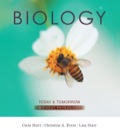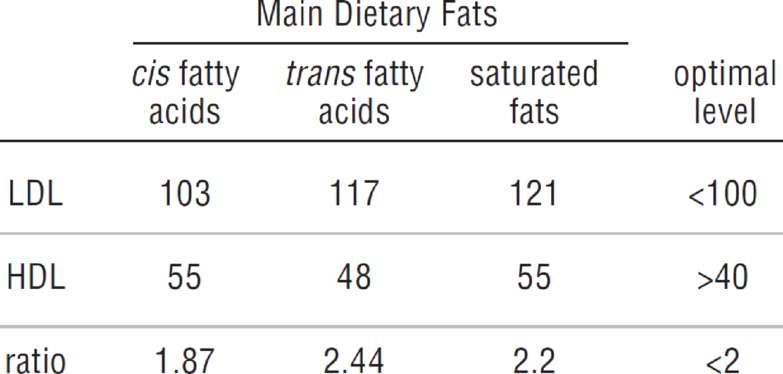
Concept explainers
Effects of Dietary Fats on Lipoprotein Levels
Cholesterol that is made by the liver or that enters the body from food does not dissolve in blood, so it is carried through the bloodstream by lipoproteins. Low-density lipoprotein (LDL) carries cholesterol to body tissues such as artery walls, where it can form deposits associated with cardiovascular disease. Thus, LDL is often called “bad” cholesterol. Highdensity lipoprotein (HDL) carries cholesterol away from tissues to the liver for disposal, so HDL is often called “good” cholesterol. In 1990, Ronald Mensink and Martijn Katan published a study that tested the effects of different dietary fats on blood lipoprotein levels. Their results are shown in Figure 2.23.

In which group was the level of HDL (“good” cholesterol) lowest?
Want to see the full answer?
Check out a sample textbook solution
Chapter 2 Solutions
EBK BIOLOGY TODAY AND TOMORROW WITHOUT
- When natural monounsaturated fats generally undergo the chemical process of partial hydrogenation, their fatty acid chains are converted into the following two forms: trans and saturated. O True Falsearrow_forwardSome foods naturally have high levels of the free amino acid. For example, parmesan cheese (1689 mg), tomato (246 mg), scallop (159 mg), corn (106 g), and shrimp (43 mg). Wheat protein (gluten) is typically comprised of 30-35% of this amino acid. People with celiac disease cannot metabolize gluten, but have no trouble with foods high in the natural amino acid or MSG. Why is this?arrow_forwardWhile not a lipid, cholesterol is often found associated with membranes. Explain how a cholesterol molecule is able to be held in place, and which parts of the cholesterol associate with which parts of the lipds. Animals like caribou (a.k.a. reindeer) that live in cold arctic regions such as the north pole often have more cholesterol in their legs than the rest of their bodies. Suggest a reason this may occur (cholesterol does not help with flight).arrow_forward
- Fatty acids are a component of fats but have distinct chemical difference apart from fats that would allow them to travel fairly freely in the aqueous environment of the blood stream. They don’t, however, and are transported with serum albumin. What about the chemistry of fatty acids makes it so that it might not be good to have a lot of them traveling freely in the bloodstream?arrow_forwardCholic acid and deoxycholic acid function in solubilizing dietary lipids in the process of digestion and thereby help in their absorption in the intestine. These molecules belong to which category of lipids? triacylglycerols O glycerophospholipids O sphingolipids terpenes steroidsarrow_forwardWhich of the following is/are true? 1. Amylose is a polysaccharide made up of galactose units. 2. Globular proteins only have structural function in the body. 3. The hydrolisis of glycerophospolipids produces one product more than the hydrolisis of triacylglycerides.arrow_forward
- Which of the following is TRUE regarding trans fat? It is less harmful than saturate fat It is commonly found in nuts and cold water fish Causes a fatty acid to have a "kink or bend" in the fatty acid structure It causes the fatty acid to appear and behave more like a saturated fatarrow_forwardDescribe TWO important roles of cholesterol that relates to human physiology with examples.arrow_forwardThe following statements are TRUE regarding carbohydrates, EXCEPT: * Carbohydrates are the most efficient and immediate source of energy Sugar units are held by glycosidic linkages that are in alpha or beta form Other than monosaccharides, sucrose is the only nonreducing form of disaccharides The type of oligosaccharides presents on the surface of the RBC determine a person's blood type None of the given optionsarrow_forward
- Which of the following statements regarding trans fatty acids is FALSE? Trans fatty acids increase the shelf-life of processed foods. Trans fatty acids were saturated fatty acids prior to hydrogenation. A diet that is rich in trans fatty acids increases the risk of heart disease, and therefore trans fatty acids in foods must be labeled. Trans fatty acids are a byproduct of hydrogenating fats.arrow_forwardList several functions of lipids in living organism. What kind of organic compound involved in fat formation contains carboxyl group.arrow_forwardWhich of the following statements about Lipopolysaccharide is FALSE? The lipid A portion is a form of bacterial toxin. The core oligosaccharide contains unusual or unique monosaccharides. The basal ring complexes are composed of the protein flagellin. O The O-linked oligosaccharide is the same "O" antigen used in specific epithets such as "0157:H7". O Lipopolysaccharide is often referred to as bacterial endotoxin.arrow_forward
 Biology: The Dynamic Science (MindTap Course List)BiologyISBN:9781305389892Author:Peter J. Russell, Paul E. Hertz, Beverly McMillanPublisher:Cengage LearningHealth Safety And Nutrition F/Young ChildHealth & NutritionISBN:9781305144767Author:MAROTZPublisher:CengageNutritional Sciences: From Fundamentals to Food, ...Health & NutritionISBN:9781337486415Author:McGuirePublisher:Cengage
Biology: The Dynamic Science (MindTap Course List)BiologyISBN:9781305389892Author:Peter J. Russell, Paul E. Hertz, Beverly McMillanPublisher:Cengage LearningHealth Safety And Nutrition F/Young ChildHealth & NutritionISBN:9781305144767Author:MAROTZPublisher:CengageNutritional Sciences: From Fundamentals to Food, ...Health & NutritionISBN:9781337486415Author:McGuirePublisher:Cengage Human Biology (MindTap Course List)BiologyISBN:9781305112100Author:Cecie Starr, Beverly McMillanPublisher:Cengage Learning
Human Biology (MindTap Course List)BiologyISBN:9781305112100Author:Cecie Starr, Beverly McMillanPublisher:Cengage Learning Biology Today and Tomorrow without Physiology (Mi...BiologyISBN:9781305117396Author:Cecie Starr, Christine Evers, Lisa StarrPublisher:Cengage Learning
Biology Today and Tomorrow without Physiology (Mi...BiologyISBN:9781305117396Author:Cecie Starr, Christine Evers, Lisa StarrPublisher:Cengage Learning





